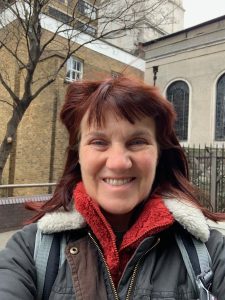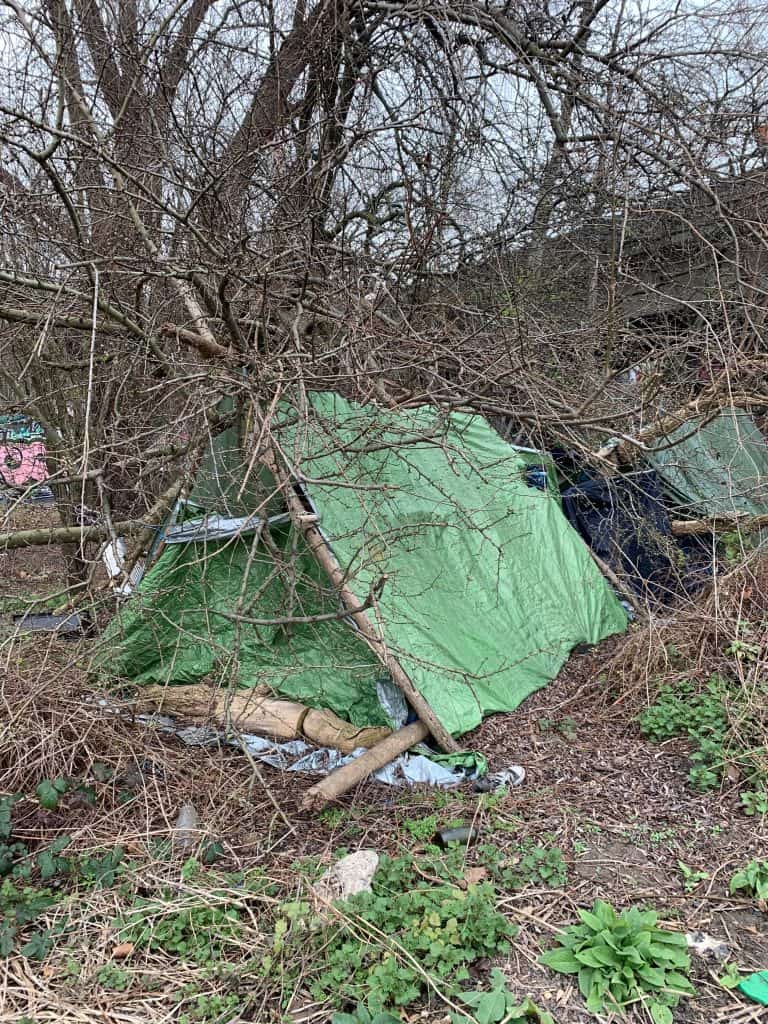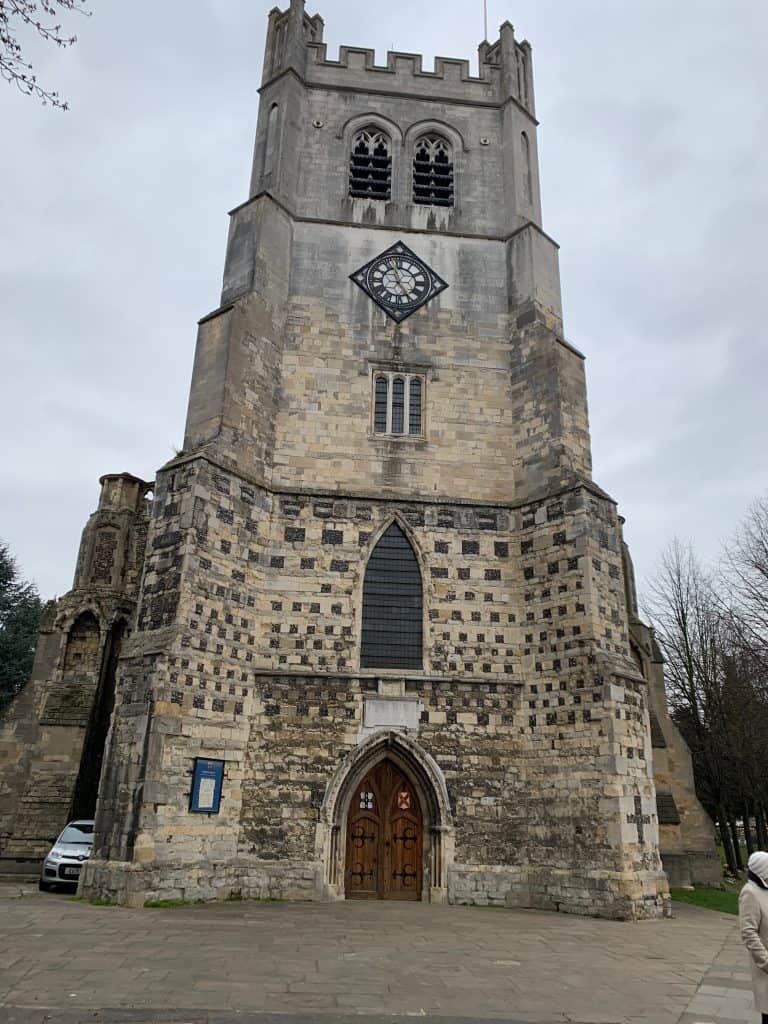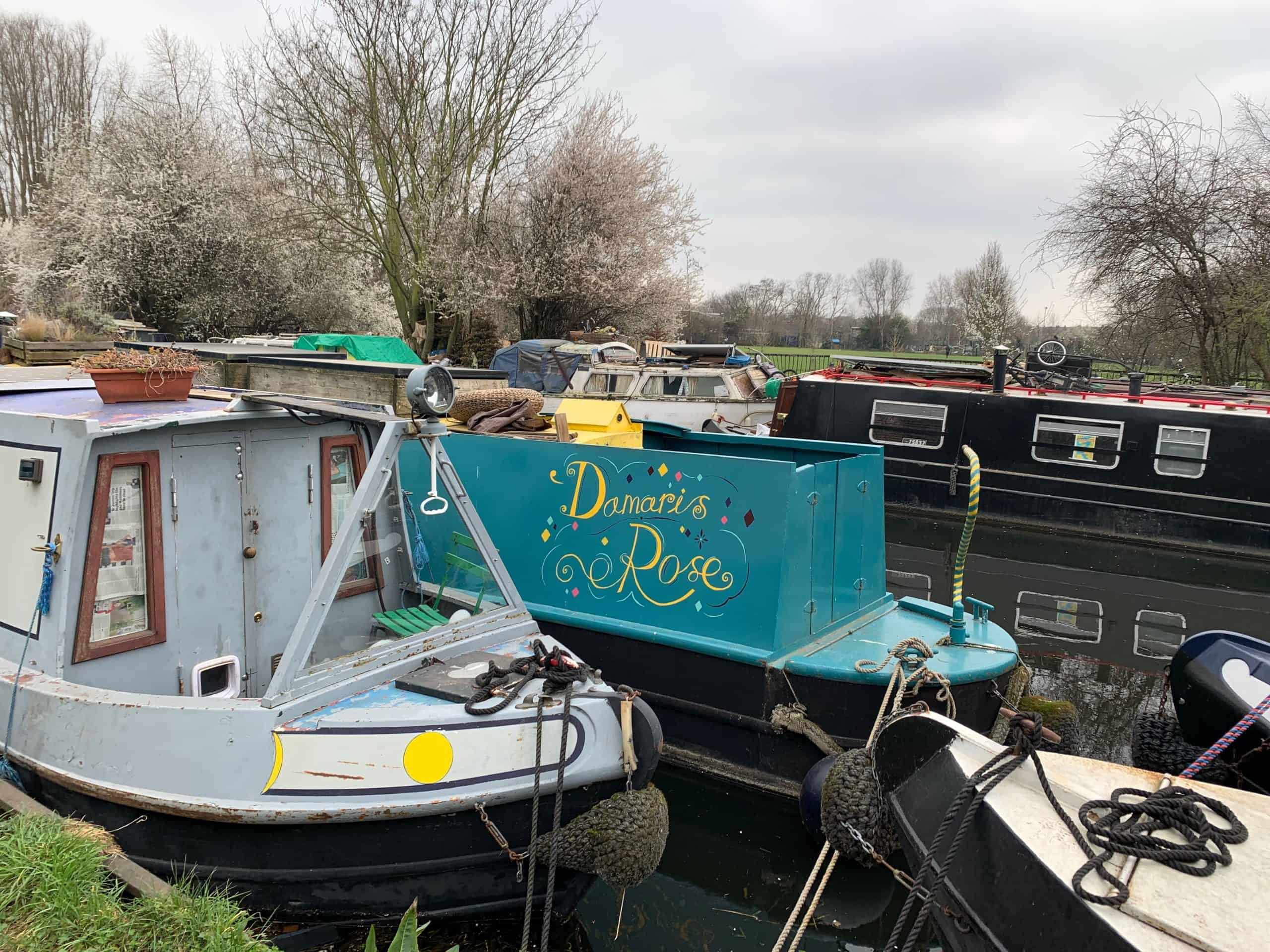Sunday 5th March 2023
Guidebook: 17.7 miles
My Garmin: 19.5 miles
I take the train to Fenchurch Street station to begin my London to Walsingham Camino on a chilly Sunday morning. The guidebook[1] tells me to expect a flat seventeen and a half miles for this first stage. I will start from St Magnus the Martyr church at the north-east corner of London bridge, and follow the River Thames, Regent’s and Hertford Union canals, and the River Lea all the way to the old pilgrim town of Waltham Abbey.
According to the guidebook, St Magnus the Martyr contains a statue of Our Lady of Walsingham and has a rector willing to bless pilgrims beginning their Walsingham Camino, but I arrive before 7.30am, and everything is locked up. So I settle for a couple of selfies outside the church before setting off eastwards along the Thames path, breathing in the wide expanse of the river with its barges and cormorants, converted wharf buildings and the remains of old wooden landing stages poking out of the mud. I pause to look across to the glistening Shard and HMS Belfast, back to London Bridge, ahead to Tower Bridge and the Mayor of London’s glass golf ball headquarters. It’s an exhilarating start.

Kings, Queens and Martyrs
I soon reach the Tower of London, which looks well cared-for and squeaky clean, readying itself for the day’s influx of tourists. Signboards along the riverside path remind me of the wealth of history here. These walls have witnessed royal celebrations and infamous cruelty. I pass Traitor’s Gate where notable prisoners including St Thomas More and Anne Boleyn were brought into the Tower on their way to imprisonment and execution. Just a few metres away, the Crown Jewels lie closely guarded, soon to fulfil their historic function again at King Charles III’s coronation. It feels appropriate to be beginning my journey in a place so rich with links between past and present. Nearly all the kings and queens of England from Henry III until Henry VIII made pilgrimages to Walsingham.
After coffee and a bun in a Costa cafe at the foot of Tower Bridge, I make a short detour to attend Sunday mass at the nearby English Martyrs Catholic church. The congregation is quite small, but the church is beautiful, designed by Pugin in vaulted, Gothic style.[2] The first reading is God’s call to Abraham: ‘Leave your country … for the land I will show you,’ which feels appropriate for the start of a pilgrimage. We end mass with a hymn to Our Lady. ‘Ave Maria, gratia plena,’ I sing, as Walsingham pilgrims have sung down the ages.

A Stamp for my Credencial
I’m soon on my way again, past St Katharine’s Dock and into Wapping, where the Thames path winds alternately along the riverside and inland between converted wharf buildings and warehouses, all luxury flats now. Runners have been passing me since the start of my walk, but they are coming in greater numbers now, out for Sunday morning exercise. Little old pubs, some with steps down to the river, remind me of the area’s less well-heeled past. I can imagine characters from a Dickens novel drinking in the Town of Ramsgate or the Captain Kidd. The gleaming vista of Canary Wharf faces me across the next bend in the river. There were only three big towers when I used to work there back around the turn of the millennium, but now the cluster of tall glassy buildings almost rivals the City. New and old, side by side; there’s something thrilling about the vitality of London and its endless capacity to reinvent itself.
Reaching Limehouse, I find the Royal Foundation of St Katharine, which is recommended in my guidebook as a place to stay or eat.[3] The Foundation dates back to the twelfth century when it was set up by Queen Matilda as a hospital for the poor. It has remained under the patronage of English queens ever since and continues to offer accommodation and various services. When I looked it up online there were no rooms available for less than £220 per night, which feels on the pricey side for a pilgrim, but you might get a better deal by booking in advance or as a group rate.
The guidebook says the Foundation has a pilgrim stamp for the Camino, so I go into the quiet and classy reception to enquire. Before starting my Camino I obtained a credencial (pilgrim passport) from the Confraternity of St James. The Confraternity exists to inform and support British pilgrims undertaking the Camino de Santiago, and it also recognises and supports a number of pilgrim routes in the UK, including the London to Walsingham Camino. You can collect stamps on your credencial as a record of your journey.[4]
The polite man on the desk says he has heard about the Camino, but I am the first person to come and ask him for a stamp. I feel a little thrill at being pilgrim number one, at least for this receptionist, and the man goes off to ask his manager about the stamp. In the end they can’t find a special pilgrim stamp, but they stamp my credencial with the Foundation’s stamp and write in the date, which all feels very satisfactory to me.
One of my favourite saints
I purchase a postcard of the beautiful icon of Saint Katharine hanging in reception. My secondary school was dedicated to Saint Katharine of Alexandria. We used to celebrate ‘St Kate’s day’ every year with hymn singing, games, entertainments,and an unusually edible lunch. Possibly for this reason, she has always been one of my favourite saints.
I stick my head into the yurt cafe in the grounds of St Katharine’s. The yurt has a different vibe from the restrained tastefulness of the main Foundation building: more local, alternative, younger, with a community garden and posters advertising musical and poetry events. It is clearly popular, full of families enjoying breakfast or a morning coffee, with no seating room available, so I continue on my way.

Boats... Lots of boats...
I soon pass the Limehouse Basin and turn left up the Regent’s Canal. The Sunday runners are coming thick and fast now, and several times I have to pause to let them pass me on the narrow towpath. Emerging from under a low tunnel I see a heron perching on the roof of a block of flats – a pleasing juxtaposition of urban living and wild nature which characterises much of the next few miles. Just as St Katharine is one of my favourite saints, herons are my favourite birds. I love their wide wings and long beak, and the way they seem content to sit motionless, as if deep in meditation, unphased by manic human activity. Soon the heron’s mate appears, and the two of them take wing together, flying up the centre of the waterway. I pause for a moment to watch them.
There are boats, lots of boats, moored all the way along the canal. Hardly any are on the move, and most look like permanent homes rather than holiday rentals. I pass narrowboats, elderly cabin cruisers and strange submarine-like vessels in faded orange which I later discover are repurposed lifeboats. Boats are piled high with people’s belongings: bicycles, wheelbarrows, fuel cans and sacks of coal, stacks of wood, and plants growing in pots and boxes. There are storage boxes and solar panels on the roofs, and smoke wafting out from the blackened chimneys of stoves. The smoke smells slightly acrid, and there’s debris and oil floating on the water. I see the curled up corpse of an animal floating beside one of the boats – a dog, perhaps or a badger? I get the impression living on a boat isn’t as easy as my romantic imagination might suggest.
Almond croissant and coffee
I reach Victoria Park in Hackney, where families, young couples and even more runners are out enjoying the open space. I’m ready for a coffee and snack now, so I turn into the Pavilion Cafe where I queue up beside an array of pricey artisan breads, granolas and nut butters. It’s achingly trendy, the menu dominated by vegan bagels with ingredients I’m not sure I’ve heard of, and very busy. I think I’m the oldest person in here. I order an Americano and an almond croissant and am served by an efficient team of staff racing to put together everyone’s orders. There’s no space to sit inside, so I find a seat under an outdoor shelter overlooking the park lake. My croissant is delicious, but the weather is cold, and I can’t linger here for long. I still have at over twelve miles to walk and calculate that I need to start picking up my pace to be finished before nightfall.
In Victoria Park I pick up the Hertford Canal and walk eastwards to meet the River Lea at the north corner of the Olympic Park. I’m suddenly on familiar territory as I used to walk or cycle along this stretch of the Lea quite often when I worked as a trainee health visitor in Hackney. The river is a little wider than the canals, but has similar boats moored along its banks. I note some of their names: Shady Lady, Evening Star, Hakuna Matata, Trotsky, Whistling Jack. Many display posters protesting a change to the rules about free riverside moorings, while others advertise a planned party and gathering for boat dwellers. I get the sense of an alternative community, living on the margins, in the city, but not of it.

Art for sale?
I have a particular interest in the boats on this stretch as it is the setting for my work-in-progress novel, The Last Midwife. It’s a story about an outlaw midwife living and working on a narrowboat in a dystopian future London. I take notes, both mentally and in my journal, of the landscape, the lifestyle, the apparent freedoms and hardships of life on the river. A few of the boats are smart, but many are dilapidated, with peeling paint, broken windows patched with plywood or plastic, and makeshift insulation lining windows where curtains are stained with mould and mildew. I notice pushchairs and hosepipes, olive trees and winter-withered herb gardens. A man is cutting up logs with a chainsaw to fuel his stove. A woman hauls water in big plastic bottles. Once or twice I pass a sunken boat, and wonder whether someone’s entire worldly possessions went down with it.
Bridges span the river, their undersides liberally decorated with graffiti. Under one wide bridge there are people making fires and living in tents, surrounded by what looks to me like heaps of rubbish, but with signs declaring it ‘Art for sale’. I’m not sure whether this is supposed to be ironic but decide to walk on past anyway.
I have to keep dodging out of the way of cyclists and remind myself to keep my eyes on the path; a sideways step into the river could bring my walk to a chilly end. I pray the rosary as I walk, but my hands are cold. I’ve still got my hat and coat on despite striding along at a decent pace. The river here is lined with housing and parks, the path busy with people. The boats get smarter as I continue northwards; some have more permanent moorings with land-based storage sheds and little gardens.
I reach a small cafe beside the Lea Valley Rowing Club and decide it is definitely lunch time. The club has a big hangar filled with rack upon rack of the long, skinny rowing boats I associate with the Oxford and Cambridge Boat Race. The cafe is crowded, and once again there is no seating room indoors. I order a bacon and egg bap and a mug of tea and devour it at an outside table overlooking the river. Refuelled, I head onwards, noticing that the soles of my feet are beginning to feel sore. Time to get out the walking poles.
Two bags to feed the ducks

Passing Springfield Park I notice a teenage lad in Orthodox Jewish attire out enjoying the afternoon with his brother who has Down Syndrome. They have come down to the river to feed the ducks, and I hear the taller boy say,
‘Guess what – we’ve got two bags-full of food today.’
‘Two bags! Two bags!’ his brother exclaims, grinning from ear to ear and bouncing with glee. He takes the first bag and begins to scatter the birdseed, entirely delighted. I am smiling as I walk on.
Tottenham lock, and beyond
At Tottenham lock there’s another sunken boat, with some sort of operation going on to raise it. There’s a lot of building work going on here too; big blocks of smart-looking apartments under construction on the other side of the river. My guidebook says this is a good spot to pick up public transport, and I’m briefly tempted to bail on the rest of today’s walk. I can feel the gravelly path though my trainers with every step, and the idea that I’m not much more than halfway to Waltham Abbey feels daunting. But I tell myself I’m still okay for now and press onwards.
Soon after Tottenham, the path crosses to the eastern bank of the river and the character of the walk changes. Until now I’ve been surrounded by the bustle of London, beset sometimes to the point of irritation by other walkers, cyclists and families out enjoying this ribbon of watery green winding its way through north-east London. Suddenly the buildings bordering the river become soulless and industrial. I slog past a huge bus depot, various factories, power stations burning the city’s rubbish to make electricity, and vast sheds of uncertain purpose. The boats thin out, and pylons process along much of the route. There are few other walkers. The steep grassed banks of reservoirs rise up to my right for mile after mile, some of them grazed by sheep, but mostly empty. Miserable looking horses stand in a soggy, over-grazed field. I spot a couple of makeshift tents in a rubbish-strewn hollow and wonder who is desperate enough to be living here.

One more step along the world I go
Probably the gloomy, overcast weather doesn’t help, and nor does the fact that I’ve been walking for four or five hours, but my spirits take a decided dip. I can’t listen to music to cheer myself up because my phone battery’s running low. I’m depending on calling Adrian to pick me up when I finish, so I can’t risk a dead phone. An old primary school hymn comes to mind, so I sing it to myself as I march onwards for mile after mile:
‘One more step along the world I go.’ It reminds me of the day my son Petrok left infant school and we sang it at his final assembly.

Pressing on
I’m alone for a lot of this stretch. I see a few fishermen, although there are signs warning against casting lines close to the overhead power cables. I watch a cormorant diving and see information boards about otters; clearly the river is healthy enough to host wildlife. I’m comforted by another of my beloved herons, perched in his patient, old man hunch among the reeds. There are one or two boats, but mostly the river is empty of humanity. A group of young people building a fire on the opposite bank call out across the river and invite me to join them. I’m surprised, and quite touched by the offer of companionship in this lonely place, but decline, saying I don’t have time today.
Sitting down beside the lock at Ponders End, I realise I would very much like the solace of a cup of tea, a cake, and the use of a toilet. Google maps tells me there is a Harvester restaurant nearby, and I decide it’s worth a short detour. But when I reach the over-sized red brick building it is half-boarded up, permanently closed, tiles slipping off the roof. Its abandonment only adds to my sense of weariness. But it’s only three or four miles to my destination now, so I press on, reminding myself that a pilgrimage, like life, can’t always be fun and easy. The tougher, less obviously rewarding bits are just as necessary.
I reach Enfield with relief. Here, at last, are pretty houses bordering the water again, a few people out and about, a return to human habitation. There’s a pub here, and a cafe a little further on, but I am nearly done now, and decide to continue under the M25 and into Waltham Abbey. I can have something to eat there while I wait for Adrian.

Waltham Abbey and the Tomb of a King
I make it into the centre of Waltham Abbey a little before five o’ clock. It’s easy to spot the old abbey church where pilgrims used to come in the Middle Ages to venerate a holy cross and pray for miracles. The church is locked up now so I can’t go inside, but I wander round into the old abbey grounds. Here I discover the tomb of King Harold, of 1066 and arrow-in-the-eye fame. Harold built the church here in gratitude for a cure from paralysis which he attributed to the cross. The cross was lost, and the abbey largely demolished in Henry VIII’s dissolution of the monasteries, but Harold’s tomb remains. Today’s walk has begun and ended with the doings of English kings.[5]

I’m too tired now to do more than photograph the tomb, mutter a vague prayer of gratitude that I’ve made it this far before nightfall, and wend my way to the twenty-first century warmth of a nearby MacDonalds restaurant. A deep-fried apple pie tastes as sweet as divine ambrosia. Sipping my tea and waiting for Adrian, I realise it’s been a good day, full of unexpected gifts. Two bags-full, at least.
Karen Lawrence is a mother, grandmother, yoga teacher and writer. She lives with husband Adrian and youngest daughter Martha in Billericay, Essex, United Kingdom. Karen has published two books and is currently working on a novel about outlaw midwives in a dystopian future Britain.
Letting the Light In: How A Baby With Down Syndrome Changed My Life is Karen’s personal account of having a baby with Down Syndrome. It is available from Amazon at
Karen’s first book, Finding Your Calm Space: Thirty-One Ways to find Calm in a Crazy World is available from Amazon at
If you would like to follow Karen and be kept up to date with her writing, please sign up at https://karenlawrenceauthor.com/join-the-mailing-list/
[1] My guidebook is the excellent London to Walsingham Camino: The Pilgrimage Guide by Andy Bull, published by Trailblazer Guides. You can see the details here
https://ldwa.org.uk/ldp/members/show_path.php?path_name=London+to+Walsingham+Camino
[2] You can learn more about the English Martyrs church and its architecture here
[3] Here is the website for the Royal Foundation of St Katharine where you can learn more about its history and book a room to stay
[4] You can get a credencial and learn more about the Confraternity of St James and its work here
[5] You can learn more about the history of Waltham Abbey here
http://www.walthamabbeychurch.co.uk/history.htm




